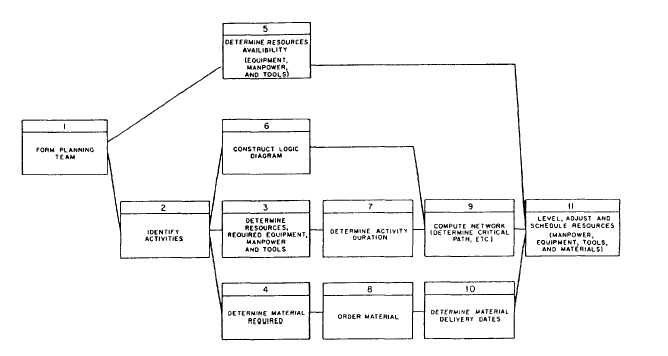for completion. Material schedules show when the material is needed on the job. They may also show the sequence in which materials should be delivered. Equipment schedules coordinate all the equipment to be used on a project. They also show when it is to be used and the amount of time each piece of equipment is required to perform the work. Manpower schedules coordinate the manpower requirements of a project and show the number of personnel required for each activity. In addition, the number of personnel of each rating (Builder, Construction Electrician, Equipment Operator, Steelworker, and Utilitiesman) required for each activity for each period of time may be shown. The time unit shown in a schedule should be some convenient interval, such as a day, a week, or a month.
NETWORK ANALYSIS
Network analysis is a method of planning and controlling projects by recording their interdependence in diagram form. This enables you to undertake each problem separately. The diagram form, known as a network diagram, is drawn so that each job is represented by an activity on the diagram, as shown in figure 9-1. The direction in which the activities are linked indicates the dependencies of the jobs on each other.
PROGRESS CONTROL
Progress control is the comparing of actual progress with scheduled progress and the steps necessary to correct deficiencies or to balance activities to meet overall objectives.
PLANNING DOCUMENTATION
LEARNING OBJECTIVE: Upon completing this section, you should be able to give the documentation requirements necessary in planning a construction project.
There are two basic ground rules in analyzing a project. First, planning and scheduling are separate operations. Second, planning must always precede scheduling. If you don't plan sequentially, you will end up with steps out of sequence and may substantially delay the project. Everyone concerned should know precisely the following aspects of a project: What it is; Its start and finish points; Its external factors, such as the schedule dates and requirements of other trade groups;

Figure 9-1 . - Planning and estimating a precedence diagram.
Continue Reading